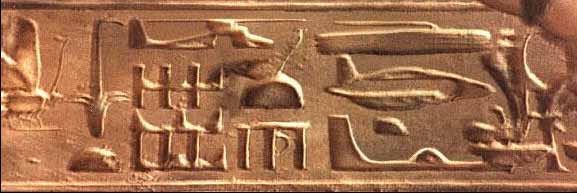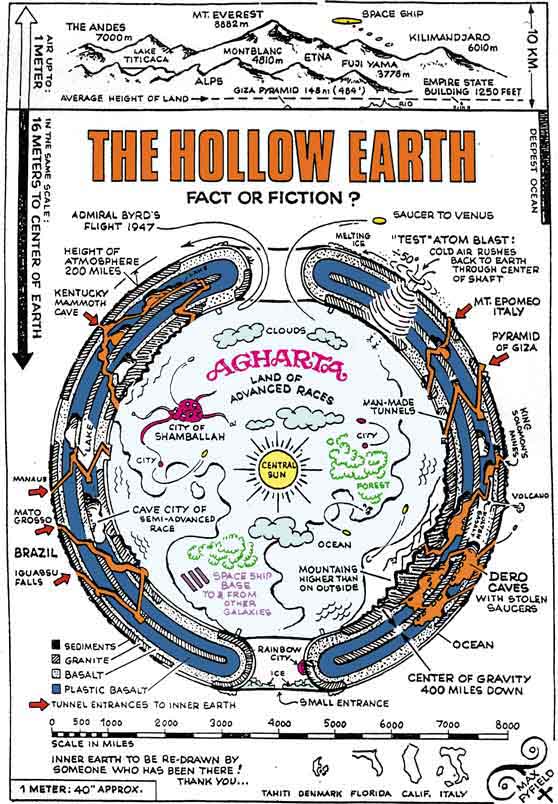Hollow Earth Hypothesis - Subterranean Civilizations - Agartha
~ AGARTHA ~
Agartha (sometimes Agartta, Agharti or Agarttha) is a legendary city that is said to reside in the Earth's core. It is related to the Hollow Earth theory and is a popular subject in Esotericism. Agartha is one of the most common names cited for the society of underground dwellers. Shamballa (also known as Shambalah or Shangri-La) is sometimes said to be its capital city.
The mythical paradise of Shamballa is known under many different names: It has been called the Forbidden Land, the Land of White Waters, the Land of Radiant Spirits, the Land of Living Fire, the Land of the Living Gods and the Land of Wonders. Hindus have known it as Aryavartha (literally : The Land or Realm of The Aryans ; the Land of the Noble/Worthy Ones") - the land from which the Vedas come; the Chinese as Hsi Tien, the Western Paradise of Hsi Wang Mu, the Royal Mother of the West; the Russian Old Believers, a nineteenth-century Christian sect, knew it as Belovodye and the Kirghiz people as Janaidar. But throughout Asia it is best known by its Sanskrit name, Shambhala, meaning 'the place of peace, of tranquillity.'
While once a popular concept, in the last century little serious attention has been paid to these conjectures (with the possibly apocryphal exception of Adolf Hitler), and the theory is not supported by modern science. The idea of subterranean worlds may have been inspired by ancient religious beliefs in Hades, Sheol, and Hell. Ferdynand Antoni Ossendowski's 1920 book Beasts, Men, and Gods also discusses Agartha. The myth of "Agartha" is also known as "Shambhala", as it was known in India, the underworld realm peopled by initiates and lead by 'the Masters", Masters who are the Spiritual leaders of humanity.
Agartha is the great Asian University of the Initiates of the Greater Mysteries. Their 'Mahatma' ('Great Soul'), Who is also known as " The Lord of The World " , plays the part of the supreme spiritual leader of humanity.
According to Alexandre Saint-Yves d'Alveydre (1842-1909) of France, the secret world of "Agartha" and all of its wisdom and wealth "will be accessible for all mankind, when Christianity lives up to the commandments which were once drafted by Moses and Jesus, meaning 'When the Anarchy which exists in our world is replaced by the Synarchy". Saint-Yves gives a 'lively' description of "Agartha" in this book as if it were a place which really exists, situated in the Himalayas in Tibet. Saint-Yves' version of the history of "Agartha" is based upon ' revealed' information, meaning received by Saint-Yves himself through 'attunement'. Saint-Yves d'Alveydre created the Archaeometre.
Shambhala concept figures prominently in Vajrayana Buddhism and Tibetan Kalachakra teachings and revived in the West by Blavatsky and Theosophical Society. As with many concepts in Vajrayana Buddhism, the idea of Shambhala is said to have an 'outer,' 'inner,' and 'secret' meaning.
The outer meaning understands Shambhala to exist as a physical place, although only individuals with the appropriate karma can reach it and experience it as such. There are various ideas about where this society is located, but it is often placed in central Asia, north of Tibet. The inner and secret meanings refer to more subtle understandings of what Shambhala represents, and are generally passed on orally. Alice Bailey transformed it into a kind of extradimensional or spiritual reality. The Roerichs see its existence as both spiritual and physical.
The Hollow Earth or hollow planet theory is also supported by superconscious knowledge based channeled sources of universal nature like Seth channeled by Jane Roberts, Ramtha by J.Z. Knight and Datre by Aona.
According to Secrets, Shamballa the Lesser, one of the colonies, was also the seat of government for the network. While Shamballa the Lesser is an inner continent, its satellite colonies are smaller enclosed ecosystems located just beneath the Earth's crust or discreetly within mountains. Cataclysms and wars taking place on the surface drove these people underground. These were said to include a lengthy Atlantean-Lemurian war and the use of thermonuclear weaponry that eventually sank and destroyed these two highly advanced civilizations. The Sahara, Gobi, the Australian Outback and the deserts of the southwestern U.S. are said to be but a few examples of the devastation that resulted. The sub-cities were created as refuges for the people and as safe havens for sacred records, teachings and technologies that were cherished by these ancient cultures.
It is believed that the great kingdom of Lemuria which was located in the Gobi desert in Mongolia was destroyed by Atlantis in a great war that led to a cataclysmic destruction of Atlantis and Mu. Mu was a great city on the surface of what is now the Gobi desert. It had 2 satellite cities by the name of Agartha Alpha and Beta that survived the destruction.
The inhabitants of Agartha are said to have scientific knowledge and expertise far beyond that of the people who live on the surface of the planet, lost technology from the days of Atlantis.
The descendants of ancient Lemuria now live in peace in subterranean caverns. The leaders of these states (variously called Ascended Masters, Guardians of the Tradition, Psychoteleios or "the perfected ones", the the Shining Ones, the Ancients, the Watchers, the Immortals, the Monitors, the Hidden Directorate, the Children of Seth, etc.) all follow what is known as the Ancient Path and do not interfere in the lives of humans that live above the surface. Nor is there any interaction between them.
There are no entrances to Agartha Alpha and Beta from any other part of the planet. The only entrances are in the Gobi desert itself and are secured by illusory technology that is beyond the comprehension of modern science.
The Tibetans refer to the cities of Agartha as Shambala and have believed for centuries in their existence as reservoirs of ancient knowledge and advanced technology.
"The Old Ones are hominid, extremely long-lived, and pre-date Homo sapiens by more than a million years. The Old Ones generally remain aloof from the surface peoples, but from time to time, they have been known to offer constructive criticism; and it has been said, they often kidnap human children to tutor and rear as their own."
Ancient philosophy states that Agartha was first colonized thousands of years ago when a holy man lead a tribe to the underground. The people have scientific knowledge and expertice far beyond that of the people who live on the surface of the planet.

The Ramayana one of the most famous texts of India, tells the story of the great avatar, Rama. It describes Rama as "an emissary from Agartha" who arrived on a Vimana. In India there is an ancient belief, still held by some, in a subterranean race of serpent people who dwell in the cities Patala and Bhogavati. According to the legend, they wage war on the kingdom of Agharta. "The Nagas," according to "The Deep Dwellers," "are described as a very advanced race or species, with a highly-developed technology. They also harbor a disdain for human beings, whom they are said to abduct, torture, interbreed with and even to eat."
The Entrances. While the entrance to Bhogavati is somewhere in the Himalayas, believers assert that Patala can be entered through the Well of Sheshna in Benares, India. Says William Michael Mott in "The Deep Dwellers": "According to herpetologist and author Sherman A. Minton, as stated in his book Venomous Reptiles, this entrance is very real, with forty steps which descend into a circular depression, to terminate at a closed stone door which is covered in bas-relief cobras.
Hollow Earth Hypothesis - Subterranean Civilizations - Agartha - Crystalinks
...read more !!!
http://www.crystalinks.com/hollowearth.html

